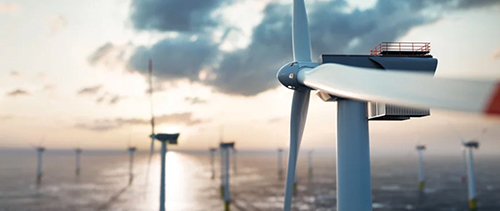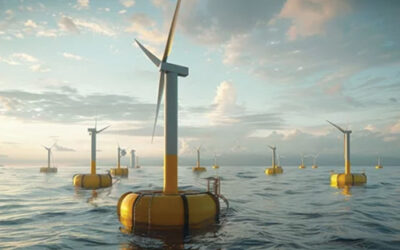The Federal Government is working on a project to install some 3 gigawatts of wind energy turbines, similar to these here, floating on the ocean offshore from San Simeon. A local group is hosting an informational event and demonstration against the plans. File photo
Critics of proposed offshore floating wind farms off the Central Coast, are getting ready for a big coming-out party and demonstration, as the proposal to install three gigawatts of wind turbine energy continues to blow a gale across the area.
The REACT Alliance (Responsible Energy Adaptation for California’s Transition; see: www.reactalliance.org) will host a “Save Our Seas Stop Offshore Wind/2024” gathering and flotilla demonstration from noon to 5 p.m. Saturday, March 9 at the Morro Bay Vet’s Hall, 209 Surf St.
From noon-1 p.m. attendees will march from the Vet’s Hall down to the Embarcadero and the South T-Pier, where they will meet up with a flotilla of watercraft — fishing boats, sailboats and kayaks — to demonstrate against the offshore, floating wind projects, and then march back to the Vet’s Hall.
Local favorite, Jill Knight will perform live from 1-2 p.m.; Mini Nova plays from 2:30-3:30 p.m.; and the Susan Ritchie Band is from 4-5.
There will be guest speakers discussing impacts to the environment in between the bands; food trucks and a silent auction; and there’ll be a kids’ zone area, too. Cost is $10 at the door.
Proceeds will support the REACT Alliance’s fight against the proposed wind farm projects, which are planned for a nearly 400-square mile patch of open ocean, some 20-30-miles off the San Simeon Coast (about 57 miles from Morro Bay, where the energy is expected to come ashore).
The non-profit group is newly born and formed some 4 months ago, according to the group’s Secretary, Andrea Lueker, a former City of Morro Bay city manager and harbor director at Port San Luis, now retired.
“This is not a political group,” Lueker said. “This is an environmental issue. We oppose the offshore wind projects, and we want to educate the public” about the potential impacts to sea life.
Their focus so far has been to bring their arguments to decision makers at the Board of Supervisors, and before State agencies that have a hand in the review of the proposals, which have grown up out of the Federal Government’s, “Bureau of Ocean Energy Management” or BOEM.
She noted they have a presentation scheduled for Feb. 27 before County Supervisors, where they will raise their multitude of concerns with the wind farms (The meeting came after EBN’s deadline, but readers can watch it on slo-span.org, where the Supervisor meetings are archived.).
The issue has brought people from different points of view with regards to the environment, united in their wariness of industrializing the ocean.
She said REACT members have already met with several officials — from the State Lands Commission, Coastal Commission and State Fish & Wildlife, with more to come. “Anyone who touches the permits or the process,” Lueker explained.
In December 2022, BOEM solicited bids for the lease sites and concluded the sale in 2023. BOEM sold the roughly 80,000-acre lease areas here to Equinor; Ocean Wind/Golden State Wind; and Invenergy/Even Keel.
The process from here includes site surveying, something Lueker said the Alliance would focus on.
“The No. 1 issue now,” she said, “are the site surveys, we believe they will start in March.”
Surveys include biological studies to determine the animals that inhabit the “Morro Bay Call Area” as the wind farm site is called. That should include the grey whale, which has a long bi-annual migration route that runs from Baja Mexico to the summer feeding grounds off Alaska. When traveling north, the female whales swim with young calves born in the Sea of Cortez.
The surveys also include mapping the seafloor with high-energy “Sound Navigation and Ranging” or SONAR devices.
The SONAR, Lueker said, “uses decibel levels that are harmful and deadly to marine mammals, and animals all through the water column.”
She noted that when Pacific Gas & Electric wanted to do SONAR mapping for a seismic study of earthquake faults offshore from Diablo Canyon Power Plant, as part of the company’s re-licensing application, there was widespread opposition.
Lueker said she was with the City of Morro Bay back then and the City Council was strongly against it. “People of all walks of life,” she said, “came together against PG&E.”
The Navy also proposed a plan to test high-power SONAR for an anti-submarine defense system, which also raised a furor of opposition, but the Navy eventually won out. “They said ‘No’ to PG&E and ‘No’ to the Navy,” Lueker said, and yet one of the wind companies plans to soon start SONAR surveying.
BOEM has already gotten the Coastal Commission to sign off on the mapping, with decibel levels up to 228.
According to a decibel chart from the National Hearing Conservation Association, the noise level standing 100-feet from a jet engine is about 140 decibels (dB); a rock concert is 115 dB. Potential hearing loss for humans with sustained exposure starts at 90 dB; and pain begins at 125 dB. Some 180 dB starts to kill off hearing tissue and the loudest sound possible is 194 dB, according to the Hearing Conservation Association’s chart.
She said the SONAR surveys would certainly damage the hearing of whales, as it is alleged to have done already off the East Coast, where she said there has been 90 dead whales wash ashore.
Though the deaths happened while site surveys for near shore wind farms were being conducted, the government has denied the surveys are the cause.
“We’re saying,” Lueker said, “that there’s a direct correlation between the site surveys and whale deaths.”
The REACT Alliance is also concerned about impacts to birds, and Lueker said their president, Mandy Davis, “speaks eloquently that the call area is sited within the Pacific Flyway,” that’s the wide path going north-south used by countless migrating bird species. The Morro Bay Estuary is a major stopover on that route.
One of the biggest impacts wind turbines have to wildlife is the ability to knock birds out of the sky with 200-foot long fan blades that Lueker said are spinning at some 170 mph at the outer tip.
On land, she said, “they are killing a significant number of eagles.”
It should be noted that BOEM has enlisted marine scientists to do biological surveys of the call area to see what bird species and marine mammals and other sea life either migrate through the call area or live there year-round.
The issue has brought together some folks that normally don’t see eye-to-eye, such as commercial fishermen and environmentalists, in opposition to the industrialization of the oceans.
“And then there’s commercial fishing,” Lueker said. She said the call area is designated essential fish habitat for albacore, swordfish, salmon and rockfish, as well as crab, squid and prawns that get fished all along the proposed power cable routes.
“Fish are also damaged from the sound surveys,” Lueker said. Other possible issues include the electro-magnetic fields associated with high-voltage power lines. “The damage is just unknown.”
And the kicker of all is that Lueker said BOEM itself years ago issued a paper that said “wind farms have no collective impacts on climate change.”
The REACT Alliance is inviting everyone to come to the March 9 event at the Vet’s Hall and see for themselves the arguments being made against this brand new industry.
“We are opposed,” to the projects, Lueker said. “But the big push is to make sure people understand what’s involved.”




